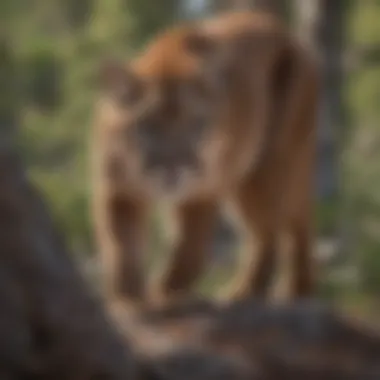Unveiling the Mysteries of Mountain Lions in the United States


Nature Topic Overview
In the vast expanse of the United States, amidst the rugged terrains and pristine wilderness, roams a secretive predator that embodies strength and stealth - the mountain lion. These majestic creatures, also known as cougars or pumas, hold a significant place in the ecosystem as apex predators. Their enigmatic presence invokes a sense of curiosity and admiration, making them a compelling subject of study and exploration.
Fun Facts and Trivia
- Mountain lions are skilled climbers and can ascend trees with remarkable agility to evade predators or hunt for prey.
- The striking coat of a mountain lion can vary from tawny to grayish, providing effective camouflage in their natural habitats.
- These elegant felines possess exceptional eyesight and hearing, essential for navigating their environment and hunting successfully. Explore these captivating creatures through interactive quizzes and captivating visuals to unravel their secrets.
Wildlife Explorations
Venture into the diverse realm of North American wildlife as we delve into species associated with mountain lions. From elusive bobcats to agile deer, the interconnectedness of these animals shapes the intricate web of life in their shared habitats. Let's uncover fascinating facts about the flora and fauna that coexist with these apex predators, enriching our understanding of the delicate balance in the wild. Engage in interactive puzzles and quizzes to test your knowledge and deepen your appreciation for nature's wonders.
Environmental Awareness
The conservation of mountain lions and their habitats is vital for preserving biodiversity and ensuring the ecological equilibrium. Discover the crucial role of sustainability and conservation efforts in safeguarding these magnificent creatures for future generations. Learn how children can contribute to nature conservation through simple yet impactful actions, empowering them to become stewards of the environment.
DIY Nature Activities
Inspire young minds to connect with nature through hands-on activities and creative projects. Engage in thrilling explorations outdoors, observing wildlife tracks or identifying local bird species. Embark on nature-inspired crafts using recycled materials, fostering creativity and environmental consciousness. Encourage children to immerse themselves in the natural world, applying their newfound knowledge through exciting and educational outdoor experiments.
Introduction
The exploration of the enigmatic world of mountain lions in the United States is a captivating journey into the realm of an apex predator that roams diverse landscapes across the country. Understanding these majestic creatures involves delving into their physical characteristics, dietary habits, and territorial behavior, unveiling intriguing insights into their survival strategies. By shedding light on historical significance, we connect with how mountain lions have played pivotal roles in Native American culture and early encounters with settlers, shaping perceptions and interactions over time.
Understanding Mountain Lions
Physical Characteristics
The physical characteristics of mountain lions are crucial in deciphering their adaptability and predatory prowess. Their muscular build, sharp retractable claws, keen eyesight, and remarkable agility serve as key features enabling them to thrive in various terrains. These attributes are essential for their stealthy hunting techniques and swift movements, making them formidable predators in the wilderness. The sleek coat and powerful jaws are distinct traits that aid in camouflage and efficient prey capture, demonstrating evolutionary advantages in their natural habitat.
Dietary Habits
Mountain lions exhibit dietary habits that reflect their role as carnivorous predators within the ecosystem. Their diet primarily consists of deer, elk, and other ungulates, reflecting a specialized feeding behavior that sustains their energy requirements. The hunting prowess of mountain lions is evident in their efficient stalking and ambushing of prey, showcasing a strategic approach to securing food resources. This dietary specialization highlights their critical position in maintaining ecological balance and biodiversity across different habitats.
Territorial Behavior
The territorial behavior of mountain lions underscores their need for vast ranging areas to fulfill their survival needs. Establishing territories helps regulate population densities and mating opportunities, reducing conflicts and ensuring access to resources. Marking territories through scent markings and vocalizations is a distinct feature that aids in communication and boundary demarcation among individuals. This behavior showcases the significance of spatial awareness and social dynamics in the hierarchical structure of mountain lion populations.


Historical Significance
Role in Native American Culture
The role of mountain lions in Native American culture holds deep symbolic importance, representing traits like strength, power, and reverence for nature. Folklore and traditions depict mountain lions as spiritual guides and guardians, embodying values of resilience and hunting prowess. These cultural associations connect human societies with the natural world, fostering mutual respect and a harmonious coexistence with these majestic creatures.
Early Encounters with Settlers
Early encounters with settlers marked a pivotal period in the perception and treatment of mountain lions in the United States. Conflicts arose due to clashes over territory and livestock predation, leading to widespread predator control measures and persecution. The historical narrative reflects changing attitudes towards wildlife conservation and ethics, shaping current conservation efforts and wildlife management practices. Understanding these interactions provides insights into the evolving human-wildlife relationships and the challenges of cohabitating in shared landscapes.
Habitat and Range
Natural Habitats
Forests
Forests stand out as one of the primary natural habitats that mountain lions inhabit. These densely wooded areas not only offer ample coverage for these elusive felines but also provide a rich source of prey species crucial for their sustenance. The dense canopy and varied undergrowth of forests create an ideal hunting ground for mountain lions, allowing them to stalk their prey with stealth and precision. However, the dense foliage can also pose challenges for human observation and research, adding a layer of mystery to these elusive creatures' lives.
Mountains
Mountains present another essential natural habitat for mountain lions, offering rugged terrain, rocky outcrops, and sparse vegetation that serve as an ideal setting for these adaptable predators. The elevation and topography of mountains provide strategic vantage points for hunting and surveying their territory, contributing to the prowess and agility of mountain lions in navigating steep slopes and rocky cliffs. Despite the challenges posed by the harsh mountain environment, these majestic felines have evolved specialized skills to thrive in such rugged landscapes.
Grasslands
Grasslands play a significant role in the habitat and range of mountain lions, offering expansive open spaces that facilitate efficient hunting and territorial movements. The vast grassy plains provide visibility for both predators and prey, enabling mountain lions to employ their keen senses of sight and hearing for successful hunting endeavors. While the open nature of grasslands can enhance hunting success, it also exposes mountain lions to potential threats and competition from other predators, highlighting the complex dynamics that govern their existence in such environments.
Geographical Distribution
Regions Across the U.S.
Exploring the geographical distribution of mountain lions across various regions in the United States unveils the diverse landscapes that these apex predators call home. From the dense forests of the Pacific Northwest to the sprawling deserts of the Southwest, mountain lions adapt to a wide array of environments, showcasing their remarkable versatility and resilience. Each region offers unique challenges and resources for mountain lions, shaping their behavior and survival strategies in response to the distinctive characteristics of the surrounding terrain.
Migration Patterns
Migration patterns play a crucial role in the habitat and range dynamics of mountain lions, influencing their movements across vast distances in search of food, mates, and suitable territories. By understanding the intricate rhythms of mountain lion migration, researchers and conservationists gain valuable insights into population dynamics, genetic diversity, and habitat connectivity essential for the long-term conservation of these magnificent predators. Despite facing various obstacles during migration, mountain lions display remarkable adaptability and resourcefulness in navigating through complex landscapes to meet their biological needs.
Behavioral Patterns


In this section, we will delve into the intricate realm of behavioral patterns exhibited by mountain lions. Understanding the behavioral patterns of these creatures is crucial as it provides insights into how they interact with their surroundings, hunt for food, and navigate their territories. By exploring the behavioral patterns of mountain lions, we can gain a deeper appreciation for their adaptive nature and survival strategies.
Hunting Strategies
Ambush Techniques
Ambush techniques play a pivotal role in the hunting strategies of mountain lions. These techniques involve stealth and patience, allowing the mountain lion to surprise its prey effectively. The key characteristic of ambush techniques is their efficacy in catching unsuspecting prey off guard. This method is advantageous for mountain lions as it conserves energy and increases hunting success rates. Despite its advantages, ambush techniques require precision and timing for optimal results.
Prey Selection
The selection of prey is a critical aspect of a mountain lion's hunting strategy. By understanding their prey selection process, we can decipher the rationale behind their choice of targets. Mountain lions often target weaker or slower animals, ensuring a higher likelihood of a successful hunt. The key characteristic of prey selection lies in the mountain lion's ability to assess the environment and choose targets that align with their hunting capabilities. This strategic approach enhances the efficiency of the hunting process but also poses challenges in locating suitable prey.
Reproductive Cycle
Exploring the reproductive cycle of mountain lions unveils the intricate rituals and periods crucial for their population's sustainability. Mating rituals are essential for the continuation of their lineage, involving complex behaviors that ensure successful breeding. The key characteristic of mating rituals is their role in strengthening social bonds and ensuring genetic diversity. While advantageous for population growth, mating rituals also create competition among males for mating rights, impacting social dynamics within mountain lion groups.
Gestation Period
The gestation period is a significant phase in the reproductive cycle of mountain lions. Understanding the duration and challenges of this period provides insights into the complexities of nurturing offspring. The key characteristic of the gestation period is its role in facilitating embryo development and preparing for birth. Despite the advantages of a defined gestation period, mountain lions face risks during this time, including predation and resource scarcity. Navigating through this vulnerable period is crucial for ensuring the survival of both the mother and offspring.
Conservation Efforts
In this section of the article, we delve into the critical aspect of conservation efforts concerning mountain lions in the United States. The preservation of this majestic species is paramount in maintaining biodiversity and ecological balance. By implementing targeted conservation initiatives, we aim to safeguard the population of mountain lions and their natural habitats.
Conservation efforts play a crucial role in mitigating the various threats that jeopardize the existence of mountain lions. Through careful planning and execution of conservation strategies, we can address issues such as habitat loss and human encroachment, which pose significant risks to these elusive creatures.
Furthermore, conservation efforts not only focus on the well-being of mountain lions but also strive to protect the entire ecosystem they inhabit. By maintaining the delicate balance of nature, conservation measures contribute to the sustainability of biodiversity in the regions where these fascinating predators roam.
Threats to Population
Habitat Loss
The detrimental impact of habitat loss on mountain lion populations cannot be overstated. As human development encroaches on their natural territories, these magnificent creatures face diminishing areas where they can thrive. The loss of vital habitats limits their ability to hunt for prey, find suitable mates, and rear offspring, ultimately leading to population declines.
Habitat loss is a critical issue for mountain lions, as it disrupts their intricate balance with the environment. The destruction of forests, mountains, and grasslands reduces the available living spaces for these apex predators, pushing them towards human habitation in search of sustenance and shelter.
To address the challenges posed by habitat loss, conservationists advocate for the preservation and restoration of wilderness areas that serve as crucial habitats for mountain lions. By enhancing protected zones and implementing sustainable land management practices, we can mitigate the negative effects of habitat loss on these majestic felines.


Human Encounters
Human encounters pose a significant threat to mountain lion populations across the United States. As urbanization spreads into wild territories, interactions between humans and these powerful predators become more frequent, leading to conflicts and fatalities on both sides. k The clash between human activities and mountain lion habitats often results in tragic consequences for these animals. Encounters with humans, whether due to accidental confrontations or intentional conflicts, put immense pressure on mountain lion populations, leading to increased stress, injuries, and even mortality.
Mitigating human encounters with mountain lions requires a multi-faceted approach that involves educating the public about coexisting harmoniously with wildlife, implementing effective deterrence methods to prevent conflicts, and establishing protocols for addressing human-wildlife interactions to ensure the safety of both humans and mountain lions.
Protection Measures
In the realm of protection measures for mountain lions, both legislative policies and wildlife sanctuaries play pivotal roles in safeguarding these majestic predators. Ensuring the long-term survival and well-being of mountain lion populations requires a combination of legal frameworks and safe havens where these creatures can thrive without fear of human intervention.
Legislative Policies
Legislative policies form the foundation of legal protection for mountain lions, delineating guidelines for their conservation and management. These policies address crucial aspects such as habitat preservation, hunting regulations, and human-wildlife conflict resolution, aimed at fostering coexistence between humans and mountain lions.
By enacting and enforcing stringent legislative measures, authorities can uphold the rights of mountain lions to exist in their natural habitats without undue harm or interference. Legislative policies serve as guardians of these magnificent creatures, ensuring that their populations remain stable and sustainable for future generations to appreciate.
Wildlife Sanctuaries
Wildlife sanctuaries serve as invaluable sanctuaries for mountain lions, offering safe environments where they can thrive and flourish without the pressures of human encroachment. These designated conservation areas provide essential habitats, food sources, and breeding grounds for mountain lions, fostering a secure space for their continued survival.
Within wildlife sanctuaries, mountain lions can roam freely, exhibit their natural behaviors, and contribute to the ecological balance of their ecosystems without facing the threats prevalent in unprotected areas. Wildlife sanctuaries act as refuges for these mesmerizing predators, ensuring their protection and well-being for generations to come.
Human Interactions
Human interactions play a crucial role in understanding the dynamics between mountain lions and humans in the United States. These interactions hold significant importance as they influence the coexistence of these majestic felines with human communities. By exploring incidents and encounters involving mountain lions, we gain insights into mitigating potential conflicts and preserving the delicate balance of the ecosystem.
Incidents and Encounters
Urban Encroachment
Urban encroachment refers to the gradual expansion of urban areas into natural habitats, impacting wildlife such as mountain lions. This phenomenon poses challenges due to habitat fragmentation, leading to increased encounters between humans and mountain lions. The key characteristic of urban encroachment lies in the transformation of wild landscapes into developed regions, creating conflicts that endanger both humans and wildlife. While urban encroachment facilitates human settlement and economic growth, it disrupts ecosystems and poses risks to wildlife survival. Balancing development with conservation efforts is crucial to ensure the sustainable coexistence of urban environments and native species, including mountain lions.
Livestock Predation
Livestock predation involves mountain lions targeting domestic animals for food, raising concerns among livestock owners and ranchers. This aspect of human-lion interactions highlights the impact of predation on agricultural practices and rural livelihoods. The key characteristic of livestock predation is the selective targeting of vulnerable livestock by mountain lions, posing economic challenges for farmers. While livestock predation is a natural behavior for mountain lions, conflicts arise when it threatens livelihoods and agricultural sustainability. Implementing effective strategies to deter predation and compensate affected farmers is essential in fostering harmony between human activities and wildlife conservation in rural areas.
Coexistence Strategies
Animal Deterrent Methods
Animal deterrent methods are essential tools for reducing conflicts between humans and mountain lions. These strategies aim to discourage mountain lions from approaching human settlements or livestock areas, minimizing potential risks to both parties. The key characteristic of animal deterrent methods is their ability to employ non-lethal techniques, such as deterrent noises or scents, to deter mountain lions without harming them. While these methods offer sustainable solutions to mitigate conflicts, their effectiveness may vary based on environmental factors and human compliance. Understanding the unique features of deterrent methods and implementing them responsibly can promote safer coexistence between humans and mountain lions without resorting to lethal measures.
Community Education
Community education plays a vital role in fostering awareness and understanding of mountain lion behavior among local residents. By informing communities about best practices for coexisting with wildlife, education initiatives aim to reduce human-lion conflicts and promote peaceful interactions. The key characteristic of community education is its emphasis on sharing knowledge about mountain lion habits, habitats, and conservation efforts with community members. While community education provides valuable insights, its success relies on active community engagement and participation. Encouraging local involvement in conservation projects and wildlife monitoring enhances community resilience and promotes a sense of responsibility towards protecting mountain lion populations in their natural habitats.







